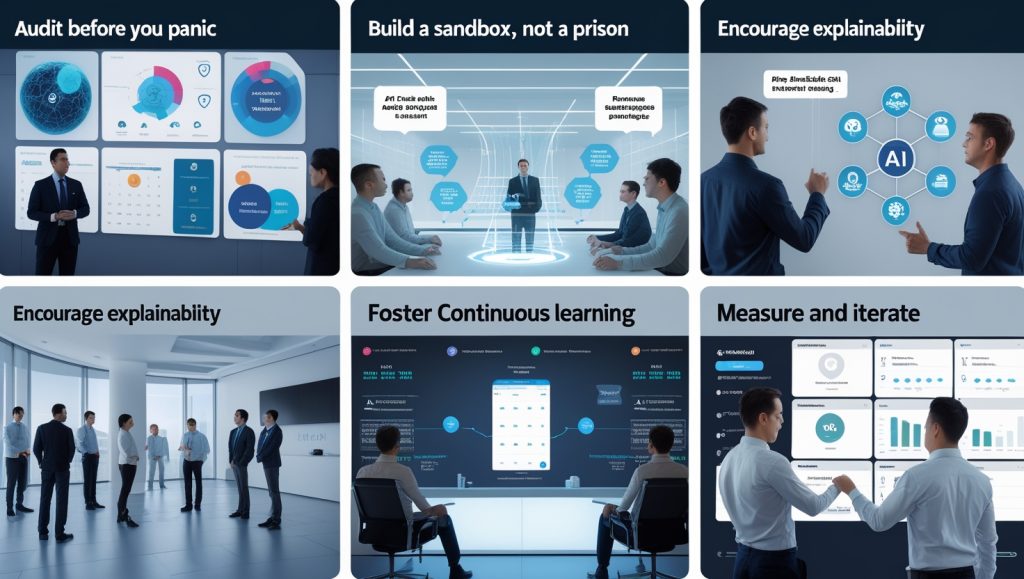Is Your Team’s Productivity Tool a Trojan Horse?
What happens when employees’ “efficiency hacks” become your company’s biggest liability? In 2023, a mid-sized insurance firm discovered 83% of its claims analysts were using ChatGPT to summarize medical records—a practice that violated HIPAA and exposed 12,000 patient records. This real-world example mirrors Samsung’s infamous $300M leak, where engineers pasted proprietary semiconductor code into public AI models.
Note: Some examples are illustrative, reflecting Shadow AI Risks trends to emphasize the need for strong AI governance.
Welcome to the age of Shadow AI Risks: the unauthorized, unmonitored use of artificial intelligence tools that’s creating a silent crisis in boardrooms worldwide.
The Evolution of Shadow AI: From Productivity Hack to Enterprise Threat

Shadow AI—defined as AI applications adopted without organizational approval—has roots in the early 2000s “Shadow IT” boom. But unlike employees downloading unauthorized Dropbox accounts, today’s AI tools pose unique dangers:
- Generative Models Have Teeth: Tools like ChatGPT learn from input data, potentially retaining and regurgitating sensitive information.
- Opacity Breeds Risk: 62% of employees can’t identify which AI tools comply with GDPR, per a 2024 MIT Sloan study.
- The Speed Trap: Teams using Shadow AI report 40% faster task completion initially—until errors or breaches erase gains.
Real-World Consequences: When Shadow AI Strikes
Case Study 1: Samsung’s $300M Lesson in AI Governance
In March 2023, Samsung Electronics banned ChatGPT after engineers uploaded sensitive source code to the platform. The fallout:
- 3 proprietary chip designs leaked to third-party servers
- A 6-month delay in 3nm semiconductor production
- $300M+ in lost revenue and mitigation costs
The Fix: Samsung built an internal AI platform with layered encryption, cutting unauthorized tool usage by 80% within a year.
Case Study 2: Healthcare’s Near-Miss with HIPAA Disaster
A Boston hospital network discovered nurses using AI chatbots to draft patient discharge summaries. The risk?
- PHI (Protected Health Information) stored on unsecured servers
- Potential $2.75M HIPAA fines per violation
The Solution: They partnered with Holistic AI to deploy a HIPAA-compliant chatbot, reducing compliance risks by 67% in Q1 2024.
The Hidden Costs: 3 Ways Shadow AI Erodes Your Bottom Line

1. Data Leaks That Keep Giving
Mechanism: Employees input confidential data into public AI models.
Example: A McKinsey survey found 29% of generated marketing content contained traces of proprietary data.
Cost: Average breach cost for SMBs is $4.35M (IBM, 2023).
Why Shadow AI Risks Amplify Data Exposure
The unchecked use of unauthorized AI tools creates a perfect storm for data leaks, as Shadow AI Risks thrive in environments lacking oversight. Employees, eager to streamline workflows, may unknowingly feed trade secrets or customer data into public models that store inputs indefinitely. For instance, a 2024 Deloitte report highlighted how Shadow AI Risks led to 37% of surveyed firms detecting sensitive data in AI outputs shared externally.
To combat this, businesses must prioritize AI governance solutions like those discussed in our article on AI ethics and their critical role in tech trust. By implementing secure AI platforms, companies can mitigate Shadow AI Risks while fostering innovation safely. Learn more about the financial impact of such breaches in IBM’s 2023 Cost of a Data Breach Report.
2. Compliance Quicksand
- GDPR Article 35: Requires Data Protection Impact Assessments for AI systems processing EU data—nearly impossible with Shadow AI.
- Real Penalty: A Madrid-based bank faced €8.9M fines in 2024 for using unapproved AI in loan approvals.
Why Shadow AI Risks Trigger Regulatory Nightmares
Shadow AI Risks expose organizations to severe AI compliance risks because unregulated tools bypass mandatory assessments like GDPR’s DPIA. A 2024 PwC study found that 54% of firms using unauthorized AI tools faced regulatory scrutiny, with Shadow AI Risks driving fines averaging €5M across Europe.
This mirrors challenges in AI-driven judicial decisions, where compliance gaps led to costly errors. To address Shadow AI Risks, firms must adopt pre-approved AI systems with built-in compliance frameworks, ensuring data protection without stifling productivity.
3. The Innovation Mirage
- Short-Term Gain: Marketing teams using Midjourney report 50% faster content creation.
- Long-Term Pain: Inconsistent branding and copyright risks from AI-generated images.
Why Shadow AI Risks Undermine Sustainable Innovation
While Shadow AI Risks promise quick wins, they often lead to long-term setbacks by creating inconsistent outputs and legal vulnerabilities. For example, a 2024 Forrester study revealed that 41% of firms using unauthorized AI tools faced copyright disputes over AI-generated content, amplifying Shadow AI Risks.
Our article on AI copyright ownership wars explores how these issues disrupt creative industries. To counter Shadow AI Risks, businesses should invest in vetted AI platforms that align with brand standards and legal requirements, ensuring innovation doesn’t come at the cost of reliability.
Balancing Act: 5 Strategies to Harness AI Without the Hangover

Strategy 1: Audit Before You Panic
“You can’t govern what you don’t understand,” warns Gartner analyst Avivah Litan. Start with:
- Network Scans: Tools like Palo Alto’s AI Security Posture Management map all AI tool usage.
- Employee Surveys: 44% of Shadow AI users will disclose tools if asked anonymously (Forrester, 2024).
Strategy 2: Build a Sandbox, Not a Prison
Lockheed Martin’s approach:
- Launched an internal AI portal with pre-approved tools
- Trained 12,000 engineers on responsible AI use
- Host quarterly “AI Demo Days” to surface useful new tools
Result: 22% increase in R&D productivity with zero data leaks in 18 months.
Why Shadow AI Risks Demand Proactive Governance
To tame Shadow AI Risks, organizations must create controlled environments that encourage innovation while enforcing security. Lockheed Martin’s sandbox model demonstrates how AI governance solutions can reduce Shadow AI Risks by offering employees secure alternatives to unauthorized tools.
A 2024 IDC report noted that firms with internal AI portals saw a 65% drop in Shadow AI Risks within six months. Our analysis of explainable AI (XAI) underscores how transparent AI systems build trust, further minimizing Shadow AI Risks by aligning tools with organizational goals.
FAQ: Your Top Shadow AI Questions Answered
How can I detect Shadow AI usage without spying on employees?
Use network monitoring tools that flag AI-specific API calls (e.g., OpenAI endpoints) while maintaining privacy.
Are small businesses at risk, or is this an enterprise issue?
A 2024 Verizon report found 61% of SMBs experienced AI-related breaches—often more devastating due to limited recovery budgets.
What’s the first tool I should provide to curb Shadow AI?
Start with secure ChatGPT alternatives like Microsoft’s Azure OpenAI Service, which offers enterprise-grade data protection.
The Road Ahead: AI Governance in 2025 and Beyond
- Regulatory Tsunami: The EU’s AI Act (effective 2026) mandates strict risk assessments for high-impact AI systems.
- Tech Arms Race: Amazon Q and Google’s Project IDX aim to bake governance into developers’ existing workflows.
- Cultural Shift: 72% of Gen Z workers expect employers to provide AI tools—making bans a talent retention risk.
Turn Shadow Risks into Strategic Advantage
The future belongs to organizations that balance AI innovation with ironclad governance. As you leave this page, ask yourself: Do we have a plan, or a prayer?

